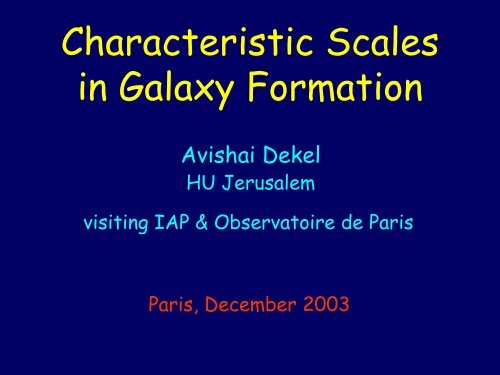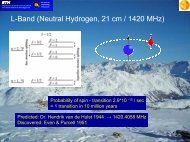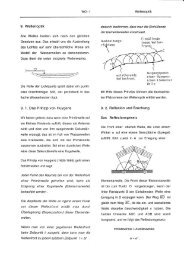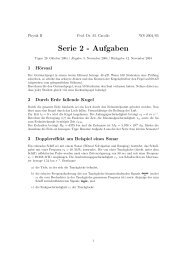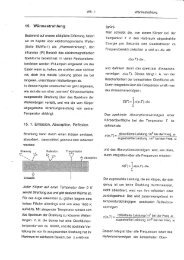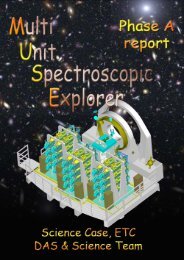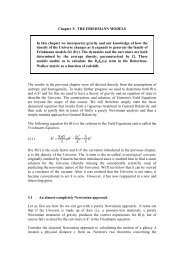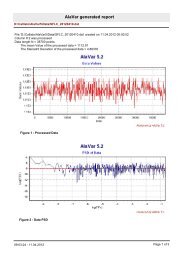Characteristic Scales in Galaxy Formation
Characteristic Scales in Galaxy Formation
Characteristic Scales in Galaxy Formation
Create successful ePaper yourself
Turn your PDF publications into a flip-book with our unique Google optimized e-Paper software.
<strong>Characteristic</strong> <strong>Scales</strong><strong>in</strong> <strong>Galaxy</strong> <strong>Formation</strong>Avishai DekelHU Jerusalemvisit<strong>in</strong>g IAP & Observatoire de ParisParis, December 2003
Four Observed <strong>Scales</strong>• galaxies V < 300 km/s• Bi-modality: M *crit ≈3x10 10 M ʘ ~L *V~ 100 km/s- discs, blue star-form<strong>in</strong>g, LSB, …- spheroids, red old-pop, HSB, AGNs, …
Bi-modality: Age vs Stellar MassSDSS Kauffmann et al. 03
Transition Scale <strong>in</strong> MetallicitySDSS Tremonti et al.
Transition <strong>in</strong> Surface Brightnessµ *SDSS Kauffmann et al. 03M * /M ʘ
Observed <strong>Scales</strong>• galaxies V < 300 km/s• Bi-modality: M *crit ≈3x10 10 M ʘ ~L *V~ 100 km/s- discs, blue star-form<strong>in</strong>g, LSB, …- spheroids, red old-pop, HSB, AGNs, …• dark-dark halos (and dSph) V < 30 km/s
Dark-Dark Halos at V < 30 km/sTF: L~V 4Virial: M~V 3ψ(M) ~ M -2φ(L) ~ L -1Cannot bereconciled !#observedgalaxiespredictedhalos10 100 1000Velocity (km/s)
Observed <strong>Scales</strong>• galaxies V < 300 km/s• Bi-modality: M *crit ≈3x10 10 M ʘ ~L *V~ 100 km/s- discs, blue star-form<strong>in</strong>g, LSB, …- spheroids, red old-pop, HSB, AGNs, …• dark-dark halos (and dSph) V < 30 km/s• dwarfs V > 10 km/s
Lower Bound?LG DwarfsV~10 km/sDekel & Woo 03
Observed <strong>Scales</strong>• galaxies V < 300 km/s• Bi-modality: M *crit ≈3x10 10 M ʘ ~L *V~ 100 km/s- discs, blue star-form<strong>in</strong>g, LSB, …- spheroids, red old-pop, HSB, AGNs, …• dark-dark halos (and dSph) V < 30 km/s• dwarfs V > 10 km/s
Theoretical <strong>Scales</strong>: Outl<strong>in</strong>eV (km/s)M * (M ʘ )M(M ʘ )Cool<strong>in</strong>g (Brems.)30010 1210 13Shock heat<strong>in</strong>g1003x10 103x10 11Supernovae1003x10 103x10 11Photoionization3010 83x10 9Cool<strong>in</strong>g (H)105x10 55x10 7
Simulations
Toy Model<strong>in</strong>g
Analytic Model<strong>in</strong>g
Semi-Analytic Model<strong>in</strong>g
Theoretical <strong>Scales</strong>: Outl<strong>in</strong>eV (km/s)M * (M ʘ )M(M ʘ )Cool<strong>in</strong>g (Brems.)30010 1210 13Shock heat<strong>in</strong>g1003x10 103x10 11Supernovae1003x10 103x10 11Photoionization3010 83x10 9Cool<strong>in</strong>g (H)105x10 55x10 7
1. Cool<strong>in</strong>g <strong>Scales</strong>
Standard Picture of Infall to a DiscRees & Ostriker 77, Silk 77, White & Rees 78, …Perturbed expansionHalo virializationGas <strong>in</strong>fall, shock heat<strong>in</strong>gat the virial radiusRadiative cool<strong>in</strong>gAccretion to disc if t cool
Cool<strong>in</strong>g vs Free FallRees & Ostriker 77, Silk 77, White & Rees 78T10 4 10 5 10 6 10 7+3log gasdensity+1dark m<strong>in</strong>i-halos-1-3lower boundtoo small-5H 2dwarfsCDMt cool
2. Shock-Heat<strong>in</strong>g ScaleIs there a virial shock?Birnboim & Dekel 03
10000Growth of a Massive <strong>Galaxy</strong>T ° K1e+007100010 11 M 10 12 M 1e+006100000radius [kpc]10010shock-heated gas1000010001“disc”1000.1100 1 2 3 4 5 6 7 8time [Gyr]Spherical hydro simulation Birnboim & Dekel 03
A Less Massive <strong>Galaxy</strong>T ° K10001e+00710010 11 M 1e+006radius [kpc]101cold <strong>in</strong>fallshocked“disc”1000001000010000.11000.010 1 2 3 4 5 6 7 8time [Gyr]10Spherical hydro simulation Birnboim & Dekel 03
Hydro Simulation: ~Massive M=3x10 11z=4M=3x10 11T vir =1.2x10 6R vir =34 kpcvirialshockKravtsov et al.
Less Massive M=1.8x10 10z=9M=1.8x10 10T vir =3.5x10 5R vir =7 kpccold<strong>in</strong>fallKravtsov et al.
Cold Streams M=3x10 11z=4M=3x10 11T vir =1.2x10 6R vir =34 kpccoldstreamsKravtsov et al.
Cold Streams M=3x10 11z=4M=3x10 11T vir =1.2x10 6R vir =34 kpccoldstreamsKravtsov et al.
Cold Streams M=3x10 11z=4M=3x10 11T vir =1.2x10 6R vir =34 kpccoldstreamsKravtsov et al.
SPH: Less Massive M=1.4x10 11z=5.5M=1.4x10 11T vir =9x10 5R vir =24 kpchotstarsCold flowsalways
Gravitational Instability Below the ShockEq. of state:Adiabatic:γ =P⎛ ∂⎜⎝ ∂= ( γ −1)ρeγ = 5 / 3lnlnP ⎞ ⎟⎠ρsstable:γ > 4 / 3radius [kpc]1000010001001011e+0071e+006100000100001000100With cool<strong>in</strong>g (rate q):γeffd(lnP)ρ ⎛ P&⎞≡ =d ρ P⎜& ρ⎟(ln ) ⎝ ⎠= γ −ρ q& ρ e0.10 1 2 3 4 5 6 7 8time [Gyr]t dynt coolBirnboim & Dekel 03e&= −PV&− q10In pre-shock quantities:γeff= γ −64( γ + 1)( γ −1)2ρ r Λ0s3u0( T )1T1=µk NBA2γ−1( γ + 1)2u20
Perturbation analysisr→r+ δrrestor<strong>in</strong>g force: δ & r / δr = ?Assume homologous <strong>in</strong>fall:ruδtur1δ = =srδt1 GMEq. of motion (sub-sonic): && r = − ∇P− = 02ρ rδr4 2−& ∝ γ − − ( γ −γeff)δr3 γStable if >0effγeff= γ −ttdyncoolStabilitycriterion:γeff2γ> γcrit= = 1.42 ( γ =γ + 2 / 35 / 3)Birnboim & Dekel 03
Gravitational Instability Below the ShockBirnboim & Dekel 03Effectiveconstant:γeff≡d(lnP)d(lnρ)= γ −ρ q& ρ e≈ γ −ttdyncoolStabilitycriterion:γeff2γ> γcrit= = 1.42 ( γ =γ + 2 / 35/ 3)
]δ(1011)=0.093timeSpherical Simulation vs Model1000 10010001052z11e+007100flow l<strong>in</strong>es1e+006radius [kpc]radius [kpc]10010101virialshock1000001000010000.1 1’disc’1000.010.10 0 1 1 2 2 3 3 4 4 5 5 6 6 7 7 8time [Gyr] [Gyr]2γ crit =1.42101γ critγ eff0at <strong>in</strong>fallγ eff-1shock formation
Model vs. 3D simulations0.2Temperature1e+0060.2γeffPost-shock Temperature"xy" u 4:5:11e+007 1.70.150.151.6Y (/h Mpc)0.10.050-0.05-0.110000010000Y (/h Mpc)Temperature (K)0.10.050-0.05-0.11e+0061.51.41000001.31.210000-0.15-0.151.1-0.21000-0.21000 1-0.2 -0.15 -0.1 -0.05 0 0.05 0.1 0.15 0.2-0.2 -0.15 -0.1 -0.05 00 0.05 0.1 0.1 0.15 0.15 0.2 0.2X (/h Mpc)X (/h Mpc)
Model vs. 3D simulations0.2Temperature1e+0060.2γeff1.70.150.151.6Y (/h Mpc)0.10.050-0.05-0.110000010000Y (/h Mpc)Temperature (K)0.10.050-0.05-0.11.51.41.31.2-0.15-0.151.1-0.21000-0.21-0.2 -0.15 -0.1 -0.05 0 0.05 0.1 0.15 0.2-0.2 -0.15 -0.1 -0.05 0 0.05 0.1 0.15 0.2X (/h Mpc)X (/h Mpc)
Critical mass for shock heat<strong>in</strong>g:Low Z high ZM halo ≈ (1-3) x 10 11 M ⊙M * ~(1-3)x10 10 M ⊙~ <strong>in</strong>sensitive to redshiftAt z ≥ 2 most halos are M
Fraction of cold/hot accretionZ=0Z=3ffMMKeres, Katz, We<strong>in</strong>berg, Dav’e 2004
Accretion Rate at Different TemperaturesZ=0Z=3 Z=5MT max /T virKeres, Katz, We<strong>in</strong>berg, Dav’e 2004
Shock-heat<strong>in</strong>g ScaleBirnboim & Dekel 03T10 4 10 5 10 6 10 7+3M * ~3x10 10 M ʘlog gasdensity+1-1-3H 2cold <strong>in</strong>fall<strong>in</strong>to discsCDMBrems.shock heat<strong>in</strong>gt cool
Implications of Cold InfallModify SFR & SN feedback. Bursts?X-rayReduce soft X-ray flux.hot gasExpla<strong>in</strong> the miss<strong>in</strong>g background?Enhance Ly-α emission.Ly-α emitters?Ly-αStromgrensphereX-rayHIIcold <strong>in</strong>fall
Effect of no virial shocksBefore: after:Creates too much soft xNaturally expla<strong>in</strong>sLyα emittersHot, diffuse,ionized–emits soft XCold, dense, neutral-emits LyαPen 1999, Wu et al. 2001, Benson et al 2000
Miss<strong>in</strong>g Soft X-ray Backgroundmodels assum<strong>in</strong>gshock heat<strong>in</strong>gobservedL x -T <strong>in</strong> clustersWu, Fabian & Nulsen 01
Ly-α EmittersLy-α Emittersskystargalaxy: cont<strong>in</strong>uum & l<strong>in</strong>eMann<strong>in</strong>g et al. 00
Ly-α at z=4.1Miley et al.
3. Supernova Feedback ScaleDekel & Silk 86Dekel & Woo 03
Simulation of supernova blowouttimeMori et al.
Galactic w<strong>in</strong>d M82
Supernova Feedback Scale(Dekel & Silk 86)Energy fed to the ISM dur<strong>in</strong>g the “adiabatic” phase:ESN≈νεM&∗trad∝M*( tradtff)M&∗ ≈ M * t ff≈ 0.01for Λ ∝ T−1atT~ 105KEnergy required for blowout:E ≈ MSNgasV2→V10crit ≈100 km/s → M∗crit≈ 3×10 M o
Supernova Feedback ScaleDekel & Silk 86T10 4 10 5 10 6 10 7+3log gasdensity+1-1-3H 2dwarfst cool
Dekel & Silk 86LSB vs HSB
LSB vs HSBSDSSµ *M * /M ʘLocal Groupdwarfsµ *M * /M ʘM *crit ~10 10 M ʘMateo 98, Woo & Dekel 03
The “Fundamental L<strong>in</strong>e” ofLSB/Dwarf Galaxies
Bright Galaxies• virial haloGMV ∝R• Mtop hatM3R∝ 200ρ2 u∗∝M• disk sizeµ<strong>in</strong>itialgas ∝fbarMR∗≈ λRsp<strong>in</strong>→λ ≈ const.2 −21 / 3* ∝ M * / R*∝ λ M ∗M→∝V3∝RM ∝ V∗→ µ ∝ M * *331/3• Z ∝ M * / M gas→ Z ∝const.
Model: fundamental l<strong>in</strong>e of LSB/Dwarfs(Dekel & Woo 03)• Energy:ESNM∝MgasV2M* / M Vgas ∝2• Virial halo:V3∝M∝R3
“Fundamental L<strong>in</strong>e” of LSB/DwarfsSurfaceBrightnessSDSSLocal Groupdwarfsµ * ∝ M *0.6µ *M * /M ʘM *crit ~10 10 M ʘµ *M * /M ʘWoo & Dekel 03
MetallicityZ∝M *0.4SDSS Tremonti et al.
LG Dwarfs: MetallicitySDSSZ ∝ M *0.4datamodel
LG Dwarfs: VelocityV ∝ M *0.2TFV>10 km/sdatamodel
Summary: SN feedbackCould be responsible for thetransition scale at M * =3x10 10 ,and the “fundamental l<strong>in</strong>e” ofLSB/dwarf galaxies, M*/M∝V 2 .
Shock Scale ≈ Supernova ScaleT10 4 10 5 10 6 10 7+3log gasdensity+1-1-3H 2dwarfsHSBLSBcold <strong>in</strong>fall<strong>in</strong>to discsM *shock ~3x10 10CDMBrems.shock heat<strong>in</strong>g-5t cool
vs M for halos <strong>in</strong> 2dFSupernovafeedbackShock heat<strong>in</strong>gAGN feedbackUs<strong>in</strong>g conditional lum<strong>in</strong>osity function: Van den Bosch, Mo, Yang 03
vs M for halos <strong>in</strong> 2dFM/LSupernovafeedbackShock heat<strong>in</strong>gAGN feedback10 11 12 13 14MUs<strong>in</strong>g conditional lum<strong>in</strong>osity function:Van den Bosch, Mo, Yang 03
Bi-Modality at M *crit ~ 3x10 10 M ʘMM critcold <strong>in</strong>fall → discs (bursts?)hi-z progenitors < M crit → discsmerge to spheroids → red, oldhot gas (+ cold flows)SN feedback regulates SFR→ blue, young popM * /M∝V 2 →LSB fundamental l<strong>in</strong>eAGN feedback prevents cool<strong>in</strong>g?Ly-α emitters?some X-ray?
4. Photoionization ScaleEvaporation byThermal W<strong>in</strong>dsShaviv & Dekel 2003
Theory: Many Sub-HalosSimulation by Moore et al.
CDM model: many dwarf satellitesMoore et al
Only a few fa<strong>in</strong>t dwarf satellitesM31Leo I (dSph)NGC 205 (dE)Antlia (Tr)FGC 227 (LSB)
It isn’t that simple to turn on the light
Search for Dark-Dark Halos
Dark-Dark Halos V
Complete removal of gas from proto-halos?By SN outflow? unlikelyBy ram pressure due to outflow from anearby galaxy (Scannapieco, Ferrara & Broadhurst 00) ?By radiative feedback?
Radiative FeedbackReionization of H by UV flux from stars and AGNby z ion ~10 → heat<strong>in</strong>g gas to T ≈(1-2)×10 4 KJeans scale – no <strong>in</strong>fall <strong>in</strong>to halos of V
Evaporation of hot gasρ gasrρ gasrkTφkTφcold gas hot gasMass loss from top of potential wellIt is cont<strong>in</strong>uously replenished and losttevap≈ tCont<strong>in</strong>uous energy <strong>in</strong>put by the ioniz<strong>in</strong>g flux→ steady w<strong>in</strong>ddyneφ / kT
Evaporated Mass FractionBarkana &Loeb 99<strong>in</strong>stantShaviv &Dekel 03w<strong>in</strong>dz ion =8z end =2
Summary Dwarf HalosDark halos must exist at V
<strong>Scales</strong> SummaryT10 4 10 5 10 6 10 7log gasdensity+3+1-1-3H 2V ionization ~30totalgaslossdwarfsHSBLSBcold <strong>in</strong>fall<strong>in</strong>to discsM *shock ~3x10 10CDMBrems.shock heat<strong>in</strong>g-5t cool
Summary: <strong>Characteristic</strong> <strong>Scales</strong>V (km/s)M * (M ʘ )M(M ʘ )Cool<strong>in</strong>g (Brems.)30010 1210 13clusters{Shock heat<strong>in</strong>gSupernovae1001003x10 103x10 103x10 113x10 11L * ,discsLSBPhotoionization3010 83x10 9dSph darkCool<strong>in</strong>g (H)105x10 55x10 7
Thank you
The Turkish astronomer (The Little Pr<strong>in</strong>ce)
What do scientists really like?
E<strong>in</strong>ste<strong>in</strong> predicts Hi-Tech
Newton?
Search for Dark Matter
CDM model: many dwarf satellitesMoore et al
A Low-Surface-Brightness <strong>Galaxy</strong>
Dark-Dark Halos must exist !virial, top-hat:M ∝ V3Tully Fisher:L∝Mx 3xx−1∝ V3x≈ 5→ dL / dM∝Mlum<strong>in</strong>osity function:mass function:∝ − αϕ( L)L α ≈1.2ψ ( M ) ∝ M− β ≈1.8⇒ ( α−1)x =β−1−γ0 →γ .2∗≈0 5/3.5≠−0.8Cannot reconcile TF with lum<strong>in</strong>osity and mass functions !βαx−β + γ( M ) dM = ϕ(L)dL → dL / dM ∝ Mf ( M )ψ ( M ) dM = ϕ(L)dL → dL / dML∝Mfraction of halos with lum<strong>in</strong>ous component:γf L ∝ M→f L∝ M0.5−0.8∝ V2L / M ∝ Vcompletely dark halos SN feedback2
Caveats• supernova feedback is a complex process:- asymmetric- thermal energy, bulk motion, turbulence• several bursts of star formation• blowout >> the escape velocity• gas miss<strong>in</strong>g also <strong>in</strong> big galaxies• do dwarfs have very massive halos?• can radiative feedback elim<strong>in</strong>ate big dwarfs?• can outflows elim<strong>in</strong>ate big nearby dwarfs?
Cool<strong>in</strong>g rate-21log Λ mic [erg cm 3 /s]-22-23Z=0.05Z=0L<strong>in</strong>e emissionZ=0.3Bremsstrahlung-244 5 6 7 8log T [K]
Observed <strong>Scales</strong>• galaxies V < 300 km/s• Bi-modality: M *crit ≈3x10 10 M ʘ ~L *V~ 100 km/s- discs, blue star-form<strong>in</strong>g, LSB, …- spheroids, red old-pop, HSB, AGNs, …• dark-dark halos (and dSph) V < 30 km/s• dwarfs V > 10 km/s
TalksOct 03 Venice 30 m<strong>in</strong>Dec 03 IAP EARA workshop 30Dec 03 Meudon 45Dec 03 IAP 45Jan 04 ETH Zurich 45


